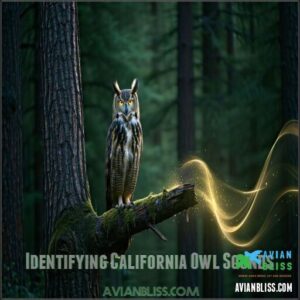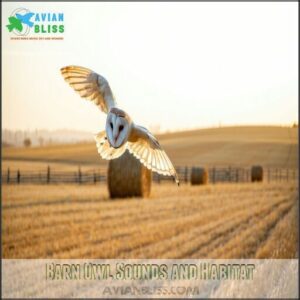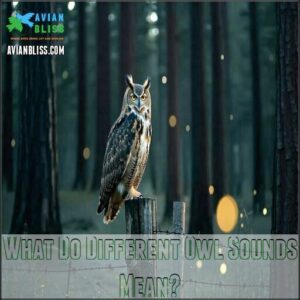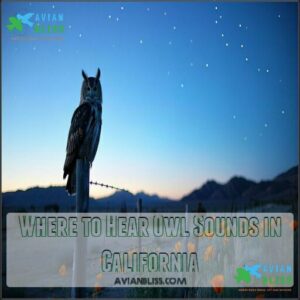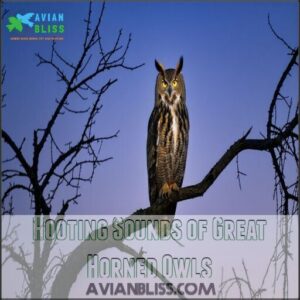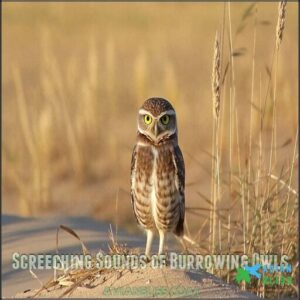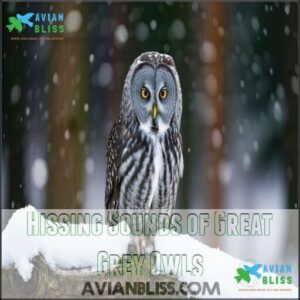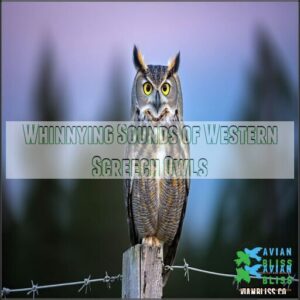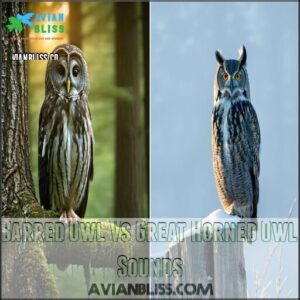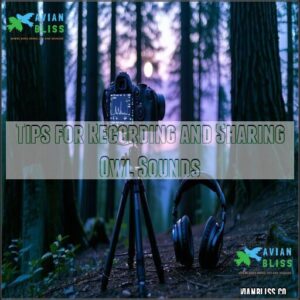This site is supported by our readers. We may earn a commission, at no cost to you, if you purchase through links.
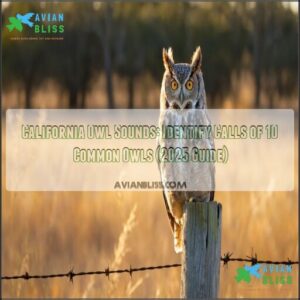
The Great Horned Owl delivers deep, rhythmic "hoo-hoo" calls, often heard at dusk.
Barn Owls, in contrast, emit eerie, high-pitched screeches that can send shivers down your spine.
Burrowing Owls have soft, chattering calls, while Western Screech Owls produce a horse-like “whinny.”
Each call serves a purpose—territory claims, mate attraction, or warnings.
Listening closely, you might notice how regional landscapes influence their sound patterns.
Want to explore these unique sounds and what they mean?
Understanding this wild orchestra can truly deepen your connection with California’s natural world.
Table Of Contents
- Key Takeaways
- Identifying California Owl Sounds
- California’s Most Common Owl Species
- Owl Sounds by Region in California
- What Do Different Owl Sounds Mean?
- Where to Hear Owl Sounds in California
- The Six Sounds of Owls in California
- Barred Owl Vs Great Horned Owl Sounds
- Conservation Efforts for California Owls
- Acoustic Monitoring of California Owls
- Tips for Recording and Sharing Owl Sounds
- Frequently Asked Questions (FAQs)
- What kind of owls hoot in California?
- What are some of the different noises owls make?
- What is the most common owl in California?
- Which owl makes the hoo hoo sound?
- What owl hoots three times?
- Is it good to hear owl sound?
- How many owls are in California?
- What sound does a spotted owl make?
- What does a owl sound like?
- What does a great horned owl sound like?
- Conclusion
Key Takeaways
- You can identify California owls by listening for unique calls like the Great Horned Owl’s deep hoots, the Barn Owl’s eerie screeches, or the Western Screech-Owl’s whinny-like trills.
- Owls use their vocalizations for specific purposes such as claiming territory, attracting mates, or warning of danger. Their sounds vary by species and habitat.
- The Great Horned Owl, with its iconic “hoo-hoo” calls, is the most common owl in California and adapts to various landscapes, including forests and urban areas.
- To enhance owl sound identification, visit diverse locations like forests, farmlands, or deserts during dusk or dawn, when owls are most vocal.
Identifying California Owl Sounds
You can identify California owls by listening for distinct calls that vary in pitch, rhythm, and purpose.
Each sound helps you understand the owl’s behavior, whether it’s defending territory, attracting a mate, or warning of danger.
This understanding is crucial as distinct calls are a key part of owl communication.
Characteristics of Owl Calls
Owls across California have unique sounds that act like nature’s coded messages, each filled with purpose and meaning.
Their vocalizations reflect their lifestyles, survival instincts, and habitats.
Great Horned Owls produce powerful, deep hoots—think of a cello playing softly at midnight.
A Great Horned Owl’s hoot resonates like an elegant midnight cello, adding depth and mystery to the nocturnal symphony.
Barn Owls, on the other hand, produce sharp, raspy screeches that pierce the quiet.
Western Screech-Owls charm you with their rhythmic trills, often heard as the sun sets or rises.
These calls vary in frequency, tone, and complexity, showcasing a symphony of owl communication.
Every sound serves a goal: claiming territory, attracting a mate, or even mimicry for protection.
Listening closely, you’ll notice their vocal artistry weaving through the nighttime soundscape.
- Call frequency differs by species.
- Sound modulation adds emotion and urgency.
- Species dialects vary by region.
- Call complexity reveals purpose.
- Acoustic adaptations suit specific habitats.
Tips for Recognizing Owl Sounds
Recognizing California owl sounds takes patience and a good ear. Start by focusing on key traits like call pitch and sound duration.
For example, a Great Horned Owl’s deep hoots resonate at 0.5 kHz, while the Western Screech-Owl’s whistles reach up to 4 kHz.
Pay attention to environmental factors—owls call most often at dawn and dusk when conditions are quieter.
Listen for regional dialects—some owl calls vary by location.
Use apps like Merlin Bird ID to match recordings with known owl vocalizations. Mimicry can be helpful too; practice replaying sounds to learn their patterns.
Soon, you’ll differentiate owl sounds and grow confident in owl identification, guided by every hoot, screech, or trill!
Common Mistakes in Identifying Owl Sounds
Identifying California owl sounds isn’t always straightforward. Many bird sounds can overlap, leading to mix-ups.
To help, watch for these common pitfalls:
- The Northern Saw-whet Owl’s rhythmic toots can trick you into thinking it’s a distant car alarm—it’s not.
- Barn Owl screeches are often mistaken for the deep hoots of Great Horned Owls, especially during breeding season.
- Birds like mockingbirds mimic owl calls so well they could fool anyone.
- Poor equipment or too much ambient noise may drown out subtle call variations, ruining owl identification.
Practice patience and sharpen your listening skills to accurately identify these nocturnal sounds!
California’s Most Common Owl Species
You’ll find a fascinating variety of owl species thriving across California’s diverse landscapes.
Each one has unique sounds, behaviors, and habitats that make identifying them both fun and informative.
Great Horned Owl Calls and Habits
In the quiet stillness of California nights, the Great Horned Owl announces its presence with a deep, echoing “hoo-h’HOO-hoo-hoo.”
This iconic sound isn’t just beautiful—it’s functional.
These calls serve as territorial songs, warning rivals and attracting mates during their mating rituals in early winter.
The Great Horned Owl stands out among California owl sounds with its bold behavior and adaptability.
You’ll often hear these hoots near forests, deserts, or even urban parks.
Regarding nesting, they’re opportunistic, taking over abandoned hawk or eagle nests.
Known for their silent flight, Great Horned Owls are skilled hunters.
They can catch prey as small as mice or as large as skunks, all without a sound.
If you listen for their hunting calls or spot evidence near an old nest, you’ve likely stumbled upon one of these remarkable creatures.
Barn Owl Sounds and Habitat
Barn owls are nature’s stealth hunters, gliding soundlessly through the California night, marked by their eerie, rasping screeches.
Their calls don’t hoot like other owls but echo like sharp, ghostly screams—lasting 2-3 seconds and famously described as a "k-r-r-r-r-ick."
You’ll often find these owls in farmlands, meadows, or open grasslands, where their hunting thrives.
- Habitat Preference: They favor open areas with few trees, perfect for spotting prey.
- Nesting Habits: Look for nests in barn lofts, hollow trees, or abandoned structures.
- Hunting Range: Larger than expected, their silent flight grants extra advantage.
Understanding their call captures California’s nocturnal magic.
Burrowing Owl Vocalizations and Behavior
A burrowing owl’s soft "coo-cooo" calls are easy to recognize among California owl sounds, especially during the day.
Unlike nocturnal owls, these small, quirky birds are diurnal, often heard while perched near abandoned prairie dog or ground squirrel burrows.
Their sharp territorial songs and vocalizations communicate with mates or warn intruders.
Cleverly, they mimic rattlesnakes to deter predators, showcasing unique owl behavior.
Don’t be surprised if you spot them hunting for insects in broad daylight or decorating burrow entrances with dung—an attraction tactic for tasty bugs—or hoarding shiny objects.
These charismatic owls are a delightful part of California’s ecosystem.
Owl Sounds by Region in California
California’s diverse regions are home to a wide range of owl species, each with unique calls that reflect their environment.
By knowing where to listen, you can identify the distinct sounds of owls from Northern forests to Southern deserts.
This approach allows for the identification of owl species based on their environment.
Northern California Owl Sounds
Northern California’s forests are alive with unforgettable owl melodies.
Amid lush redwoods and mountain peaks, you’ll hear some of the most enchanting California bird sounds, especially at dawn and dusk.
Northern California owls like these fill the night air:
- Northern Saw-whet Owl: A rhythmic "toot-toot-toot-toot," almost like a metronome ticking.
- Spotted Owl: Up to 13 unique hoots, barks, or whistles, each with its purpose.
- Great Horned Owl: Deep, commanding "hoo-h’HOO-hoo-hoo" echoes through forests.
- Barred Owl: Their call sings, “Who-cooks-for-you.”
- Pygmy-Owl: High-pitched toots, like a whistle’s rapid tune.
From Bay Area owls to Sierra Nevada sounds, Northern California is an auditory treasure.
Central California Owl Sounds
Central California offers rich habitat soundscapes with fascinating owl species like the Western Screech-Owl, Barn Owl, Great Horned Owl, and Burrowing Owl.
In oak woodlands, you’ll hear the Western Screech-Owl’s soft, whinny-like trills. Barn Owls bring haunting screams to farmlands, while Great Horned Owls dominate with their deep, rhythmic hoots in foothill regions.
Burrowing Owls, often in grasslands, charm listeners with their gentle “coo-coooo” calls, especially at dawn and dusk.
| Owl Species | Habitat | Unique Call |
|---|---|---|
| Western Screech-Owl | Oak woodlands | Whinny-like trills |
| Barn Owl | Farmlands | Haunting screams |
| Great Horned Owl | Foothill regions | Deep rhythmic hoots |
| Burrowing Owl | Grasslands | Gentle coo-coooo |
| Barn Owl | Agricultural fields | High-pitched screams |
Listening during January-February mating season reveals their vibrant regional variations within California wildlife sounds.
Southern California Owl Sounds
Southern California is a hotspot for unique owl calls in diverse landscapes. From deserts to cities, each species adds its voice to the region’s soundscape.
The Burrowing Owl, a desert dweller, is known for its soft "coo-coooo" calls that sometimes mimic a gentle wheeze. Its vocalizations can often be heard near dry, open areas.
Meanwhile, the Great Horned Owl belts out deep, resonant hoots in suburban parks or wooded areas. These calls are especially haunting at dawn or dusk, echoing like nature’s own symphony.
The Barn Owl contributes its eerie, high-pitched screams, perfectly suited for quiet nights in Southern California woodlands. If you’re near canyon ecosystems, keep an ear out for the Western Screech-Owl’s distinctive whinny.
- Joshua Tree: Burrowing Owls
- San Diego Wetlands: Barn Owls
- Laguna Hills: Great Horned Owls
- Orange County Parks: Western Screech-Owls
Owls also face significant habitat loss due to urbanization.
What Do Different Owl Sounds Mean?
Owls use different sounds to communicate, marking territory, attracting mates, or warning of danger. By recognizing these calls, you can better understand their behavior and role in the ecosystem.
Territorial Calls and Mating Sounds
Owls fill the night with calls that speak of territorial authority and allure.
Each species has unique sound variations for claiming space and attracting mates. Great Horned Owls often perform synchronized hooting rituals, blending calls into duets that strengthen their bond.
Barn Owls’ high-pitched screeches signal availability during mating rituals, while Burrowing Owls chatter near burrows to connect with partners.
During breeding seasons, call frequency spikes as males and females coordinate their acoustic ranges. Vocal communication is essential for mating success.
These California owl sounds weave social stories into the darkness, creating a unique auditory experience that is both fascinating and essential to their behavior, with vocal communication being a crucial aspect of their interactions.
Warning Calls and Alarm Sounds
Owls in California have distinct ways of detecting threats and protecting their own.
Masterful nocturnal defenders, California owls use sharp calls and mimicry to alert, intimidate, and ward off potential threats.
Warning calls are like nature’s sirens, alerting to nearby dangers.
As you listen, you’ll notice how specific their distress signals are:
- Barn owls hiss harsh rasps to ward off predators.
- Great horned owls blast sharp hoots designed to intimidate.
- Burrowing owls emit rapid chatter to defend nests.
- Spotted owls release piercing cries signaling immediate danger.
- Western screech-owls use fast, repetitive calls to detect threats.
Understanding these calls showcases their acoustic range and species variation, offering insight into elegant bird defense mechanisms.
Owl calls in California are fascinating tools of survival!
Contact Calls and Communication Sounds
Listening at twilight reveals the fascinating world of owl communication systems.
Contact calls, or "owl dialects," are the softer sounds owls use to stay connected with their families. These intimate vocalizations occur during pair bonding and routine social interactions, creating a symphony of connection within California’s wildlife sounds.
Here are three common contact calls you might recognize:
- Barn Owl’s soft chirps – A rhythmic "kek-kek-kek" often heard during nesting season, strengthening mate bonds.
- Great Horned Owl’s gentle hoots – A soothing "hoo-h’HOO-hoo" used by parents to guide fledglings.
- Western Screech-Owl’s trills – Descending whistles signaling safety or coordination within families.
Distinct from distress signals or territorial cries, these tender owl calls highlight their intricate family communication and species recognition in California’s natural soundscape.
Where to Hear Owl Sounds in California
You can hear owl sounds across California’s diverse habitats, from dense forests to open grasslands.
Visit these areas during the early evening or just before sunrise, when owls are most vocal and easier to locate.
Best Locations for Owl Spotting
If you’re enthusiastic to experience the magic of owl calls in California, you’re in luck—this state offers incredible owl-watching opportunities in diverse settings.
Start with Mountain Sanctuaries like Yosemite National Park or the Sierra Nevada, where Great Grey and California Spotted Owls can be heard among towering pines.
Coastal Hotspots such as Point Reyes National Seashore boast Barn and Short-Eared Owl sightings, their haunting calls echoing over grassy dunes. For those exploring Desert Habitats, head to Joshua Tree National Park or Mojave National Preserve to spot Burrowing or even Elf Owls as they hunt in open terrain.
Prefer a local adventure? Urban Havens, like city parks, often shelter Western Screech or even Great Horned Owls. To enhance your viewing experience, consider specialized owl equipment.
Seasonal Variations make locations like Redwood National and State Parks perfect in spring for spotting Northern Spotted Owls.
Every setting offers a chance to witness unique owl calls in California’s diverse wildlife sounds.
Time of Day for Hearing Owl Sounds
After scouting good locations, timing is key to hearing owl calls in California. Owls follow predictable rhythms based on their nocturnal nature and seasonal variations.
- Pre-dawn: Listen 30 minutes before sunrise as owls wrap up hunting.
- Dusk gatherings: Start at twilight for peak activity, especially urban owls adapting to human spaces.
- Late-night serenades: Between 9 PM-1 AM, nocturnal birds like Great Horned Owls dominate California wildlife sounds.
Interested listeners can research specific owl vocalizations for ideal timing.
- Weather effects: Clear, calm nights enhance your experience.
Quietly settle in, and you’ll catch the hauntingly beautiful calls of these impressive owl species.
Tips for Getting Close to Owls
Getting close to owls requires a mindful approach to keep them safe while enjoying their beauty.
Their extraordinary owl camouflage helps them blend into trees, so a silent approach is essential to observe them undisturbed.
Stick to these ethical considerations for a rewarding experience:
- Respect boundaries: Watch from a distance using binoculars instead of moving closer.
- Minimize disturbance: Avoid sudden movements or loud noises, as these can end their calls.
- Skip flash photography: Bright light can stress owls and negatively impact their behavior.
- Blend into surroundings: Wear neutral colors to avoid disrupting their natural habitat.
Consider using specialized viewing equipment to enhance your observation.
By acting thoughtfully, you’ll protect these majestic birds and enhance your California owl identification and observation experience.
The Six Sounds of Owls in California
You’ll recognize six distinct owl sounds across California, each tied to a specific species.
From hoots to screeches, these calls reveal fascinating behaviors and help you identify these unique birds.
Hooting Sounds of Great Horned Owls
The great horned owl in California is famous for its rich, deep "hoo-h’HOO-hoo" hoots, echoing through dusk and dawn.
These calls serve multiple purposes like marking territory or attracting a mate. Hooting variations, often duet hooting, occur between pairs, creating a mysterious back-and-forth rhythm.
Juvenile hooting, on the other hand, has a rougher, unpolished quality.
Here’s a quick reference:
| Hoot Feature | Description | Best Time Heard |
|---|---|---|
| Hooting Pattern | hoo-h’HOO-hoo | Twilight |
| Hooting Frequency | Low and resonant | Evening hours |
| Hooting Purpose | Territorial and mating | Night |
| Juvenile Hooting | Nasal, scratchy notes | Dusk |
These distinctive owl calls in California often symbolize mystery and wisdom, charming anyone lucky enough to hear them.
Whistling Sounds of Barn Owls
Barn Owls in California are known for their haunting, whistling sounds that echo through the night, setting them apart from most other owls.
These unique owl vocalizations serve diverse roles in their nocturnal lives.
Here’s what you’ll typically hear:
- A loud, piercing "shreeeeek," resembling a scream, often signals distress or warning.
- Soft, raspy hisses indicate mild threats or disturbances nearby.
- Gentle, rhythmic whistles between mates reflect whistle variation used during courtship.
- Juvenile whistles are softer, snoring-like begging calls that demand food.
Found near abandoned barns, grasslands, and farmlands, these owl calls in California provide a fascinating insight into regional dialects of bird calls and reflect adaptability.
Keep your ears open at dusk!
Screeching Sounds of Burrowing Owls
Burrowing Owls in California’s grasslands are teeming with life, and their unique screech variations make them stand out.
Their calls include a distinct "coo-coooo" that ends with a soft wheeze—perfect for distinguishing them from other bird vocalizations.
If you’re lucky, you might hear their infamous nocturnal screeching, a sharp, raspy sound that signals burrow defense against potential threats.
Even more fascinating, these owls sometimes mimic rattlesnake sounds, a clever strategy to deter predators near their underground homes.
Listen at dusk when their juvenile screeching often blends with adult warning calls, creating a fascinating array of regional dialects across the state.
- **Feel connected.
** Their sounds reveal family life beneath the surface.
- **Feel curious.
** Each call tells a survival story.
- **Feel amazed.
** Burrowing Owls mimic nature’s predators!
Hissing Sounds of Great Grey Owls
Hearing a hissing sound might make you think of a snake, but it could actually be a Great Gray Owl. Among the largest owl species in California’s Sierra Nevada, these owls emit hissing as a warning signal or when feeling stressed.
Even juveniles produce distress hisses when threatened, adding a sense of urgency to their calls. Typically active at twilight, Great Gray Owls are known for their silent flight and impressive hearing, making them effective yet stealthy hunters.
Their hissing is just one example of the fascinating owl sounds in media and nature. Here’s a quick view of their hissing:
| Context | Juvenile Hissing | Frequency | Variation |
|---|---|---|---|
| Nest Defense | Present | Low-Pitched | Steady and Intense |
| Signs of Stress | Adults and Fledglings | Soft or Loud | Slight, depending on threat |
Chattering Sounds of Northern Pygmy Owls
The Northern Pygmy Owl’s chattering sounds are intriguing and versatile.
These tiny, fierce owls produce high-pitched vocalizations often heard during daylight.
Their calls vary based on purpose:
- Defensive trills to warn intruders or assert boundaries.
- Toot-toot-toot rhythms that signal prey activity or communicate in pairs during duet chatters.
- Rapid sequences used by juveniles or during urban chatters for social interaction.
These vocal nuances stand out among owl species California hosts, creating a vibrant soundscape.
Their chatter function showcases adaptable owl calls California bird enthusiasts love to identify.
Whinnying Sounds of Western Screech Owls
The Western Screech-Owl, known for its enchanting whinnying variations, brings the night alive with its unique sounds.
Its call resembles a quick, descending horse-like neigh. You’ll often hear these owl calls in California’s wooded areas, particularly at dusk and dawn when they’re most active.
This species, a staple among owl species in California, uses whinnies for territory marking and communication. They’re primarily nocturnal, and hunt from perches using their keen senses.
- The purpose of whinnies, like defending habitat or attracting mates.
- Their regional dialects, which vary slightly by location.
- Recording whinnies carefully, as decibel levels change with distance.
Listening closely helps you appreciate this small owl’s fascinating vocal patterns.
Barred Owl Vs Great Horned Owl Sounds
In the context of identifying owl calls, the Barred Owl and Great Horned Owl are frequently mistaken for one another.
You’ll notice the Barred Owl’s signature “who-cooks-for-you” cadence differs sharply from the Great Horned Owl’s deep, rhythmic hoots.
Comparing The Two Owl Species
Barred Owls and Great Horned Owls are two fascinating owl species in California.
You can tell them apart by their size, appearance, and behavior. Barred Owls are medium-sized and marked with gray vertical bars, while Great Horned Owls are larger with brown horizontal streaks.
They share some habitat overlap in forests but differ in preferences—Barred Owls favor dense woodlands, while Great Horned Owls adapt to various landscapes.
Here’s a comparison:
| Feature | Barred Owl | Great Horned Owl |
|---|---|---|
| Size Comparison | 16–24 inches | 18–25 inches |
| Color | Gray with vertical bars | Brown with horizontal streaks |
| Hunting Styles | Stealthy glider | Powerful swooper |
| Diet | Small mammals, birds | Mammals, reptiles, birds |
| Nesting | Tree cavities | Abandoned nests |
Their call variations also reflect their unique identities, so careful listening helps with owl species identification.
Identifying Barred Owl Calls
Barred Owl vocalizations are distinctive, often described as the playful “Who cooks for YOU?” hoots echoing across forest canopies. These owls produce a variety of sounds, including soft gurgles, wild cackles, and occasional mimicry of other species.
Their calls, rich with regional dialects, are most noticeable at dusk or dawn, particularly in winter when they’re more vocal during breeding. Using bird field guides or recording analysis tools can help you differentiate Barred Owl sounds, enriching your bird acoustics knowledge.
Here’s a quick guide:
| Call Type | Pitch | Common Location |
|---|---|---|
| Hooting | Low | Dense Forest |
| Gurgling | Soft | Near Water |
| Cackling | Wild | Forest Edge |
| Chirps | High | Forest Trails |
| Mimicry | Mixed | Mixed Habitats |
Listen closely—nature has its stories! The ability to identify these distinctive sounds is key to understanding the behavior and habitat of the Barred Owl, making recording analysis tools a valuable asset for any bird enthusiast.
Identifying Great Horned Owl Calls
The Great Horned Owl’s hoots dominate California nights, creating a soundscape that’s rich and unmistakable.
Their iconic "hoo-H’HOO-hoo" call resonates deeply, carrying across great distances.
These owl sounds vary based on the bird’s purpose, time, and even sex differences.
Great Horned Owls use distinct calls to communicate.
Males often hoot with a deeper tone, while females may produce higher-pitched sounds.
Juvenile calls, softer and higher, are often mistaken for other bird audio.
Here’s a simple breakdown:
| Call Type | Pattern |
|---|---|
| Territorial | Slow “hoo-hoos” |
| Mating | Faster sequences |
| Alarm | Loud screeches |
| Contact | Soft "hoo-hoo" |
Environmental factors, like wind, impact clarity, but mimicry potential is minimal for identifying this owl.
Conservation Efforts for California Owls
You can play a key role in protecting owls by understanding the challenges they face, like habitat loss and climate change.
Conservation efforts focus on preserving nesting areas, restoring natural environments, and closely monitoring populations to guarantee their survival.
Threats to Owl Populations in California
Why are California’s magnificent night birds becoming increasingly harder to hear in the wild? While you enjoy observing owl calls, these creatures face serious threats to their survival.
California owl populations are declining due to multiple pressures:
- Habitat loss from wildfires and development fragments the ancient forests where spotted owls have nested for generations
- Rodenticides poison owls when they consume contaminated prey, creating a deadly chain reaction in the ecosystem
- Climate change forces owls to adapt to shifting prey patterns and more frequent extreme weather events
Vehicle strikes claim countless owl lives annually, particularly affecting barn owls hunting near roadways. Barred owls outcompete native species, while urban noise disrupts hunting and communication patterns.
Drought and beetle infestations weaken remaining forests, further degrading habitat quality. Electrocution risks from power lines pose additional threats, making owl conservation California’s growing concern.
Habitat Preservation and Restoration
While threats to owl populations continue to grow, habitat preservation offers hope for California’s beloved nocturnal birds.
Protecting and restoring owl habitats is straightforward but requires dedicated action. Habitat loss and urban encroachment have dramatically reduced suitable environments for owls, affecting nesting sites and prey availability throughout the state.
You can contribute to owl conservation California efforts through these simple actions:
- Install owl boxes on your property to provide alternative nesting sites when natural cavities are scarce
- Support reforestation efforts that focus on native tree species owls depend on
- Leave dead trees standing when safe, as they provide vital habitat for cavity-nesting owl species
- Reduce outdoor lighting that disrupts owls’ hunting patterns and natural behaviors
Habitat protection benefits entire ecosystems, not just owls. When you help preserve the mature forests, grasslands, and open spaces owls need, you’re creating a legacy of habitat restoration that guarantees these mysterious birds will continue their nighttime serenades for generations to come.
Research and Monitoring of Owl Populations
California’s owl research reveals critical insights through sound.
Scientists track population trends and monitor breeding patterns by recording distinctive calls across different habitats.
Advanced monitoring technology helps researchers identify declining species before critical population loss occurs.
Habitat studies combined with conservation genetics provide a complete picture of each owl species’ needs.
You can contribute through citizen science projects that use bird sound recognition apps to document owl activity in your area, directly supporting owl conservation efforts throughout the state.
Acoustic Monitoring of California Owls
You can now track California’s owl populations through sound recordings that capture their unique calls without disturbing the birds.
These acoustic monitoring systems help scientists collect data on owl distribution, behavior, and population trends across different habitats and seasons, which is crucial for understanding population trends.
Using Technology to Track Owl Sounds
Technology has revolutionized how researchers track owl sounds across California’s diverse habitats.
Modern tools allow scientists to monitor these elusive birds without disturbing their natural behaviors.
- Sound Recorders like autonomous recording units capture hours of owl calls in remote locations
- AI Analysis software such as BirdNET processes recordings to identify specific owl species with increasing accuracy
- GPS Tracking systems pinpoint exact locations where calls were recorded, creating detailed habitat maps
- Data Visualization tools transform complex acoustic data into understandable patterns for researchers
These innovations help scientists document declining owl populations while minimizing human interference.
You can even participate through Citizen Science projects that collect bird audio recordings for analysis.
Thanks to these technologies, bird acoustics research continues to advance our understanding of California’s owl species.
Benefits of Acoustic Monitoring
Recent studies show that acoustic monitoring provides remarkable advantages for owl research and conservation.
By analyzing over 700,000 hours of bird sound recordings across California’s Sierra Nevada, scientists gain unprecedented insights without disturbing natural behaviors.
This non-invasive approach offers substantial benefits for owl observation:
- Cost Effectiveness: Costs approximately half as much as traditional field surveys while collecting vastly more data
- Species Identification: Successfully detects spotted owls even in areas with high barred owl density
- Habitat Assessment: Links bird diversity to forest conditions, supporting smarter conservation planning
- Population Trends: Provides continuous monitoring data to track community changes over time
Bird acoustic monitoring serves as a "blueprint" for modern conservation efforts, allowing researchers to study owl populations across 6 million acres of forest that would be impossible to survey on foot.
This is an effective method of passive acoustic monitoring.
Challenges and Limitations of Acoustic Monitoring
Monitoring owls through acoustic methods comes with its share of hurdles. Environmental noise—like wind, traffic, or streams—can muddy recordings, leaving you guessing during data analysis.
Even advanced tools face challenges when bird sound overlap occurs, making species identification tricky. Imagine an owl’s call drowning under songbird chatter—frustrating, right?
Adding to this, owls aren’t predictable performers. Weather, moon phases, or nearby human activity can silence their calls. Extended survey times might help, but you’ll still face nights of quiet.
Equipment limitations also matter. Recording devices can fail in extreme weather, like scorching deserts or damp coastal zones. Testing gear ahead of time minimizes risks. Even habitat interference plays a role—dense forests may absorb bird acoustic signals, distorting bird sound recordings.
Acoustic monitoring indicates a concerning decline in California Spotted Owl populations.
Success in bird monitoring requires patience, sharp skills, and some luck—no shortcuts here!
Tips for Recording and Sharing Owl Sounds
Recording and sharing owl sounds can help you connect with nature and contribute to conservation efforts.
By using the right equipment and focusing on clear audio quality, you can capture these unique calls effectively.
Best Equipment for Recording Owl Sounds
Recording owl sounds in California’s serene nights requires the right tools.
With proper gear, you’ll capture every hoot, screech, and flutter like a pro.
- Microphones: Choose a shotgun mic for precise recording of bird acoustic signals amidst nature’s background.
- Recorders: Models like Zoom H5 offer portability, crisp audio quality, and long battery life—perfect for fieldwork.
- Wind Protection: Use windshields to shield against gusts that disrupt owl calls.
- Headphones: Over-ear options help you monitor subtle bird sound analysis.
- Software: Editing tools refine bird bioacoustics, cleaning up noise for clearer signals.
Quality equipment helps transform bird sound processing into a science that captures nature’s magic!
Tips for Recording High-Quality Audio
Capturing clear owl sounds begins with smart microphone selection—a shotgun mic isolates vocalizations beautifully.
For the best recording environment, pick calm, early mornings (2–4 AM), and keep your mic about 25 feet from a perch.
Adjust audio levels manually and use a windscreen for noise reduction in breezy spots.
Save files as uncompressed WAV for crisp edits.
Here’s a quick-reference table:
| Aspect | Recommendation | Why it Helps |
|---|---|---|
| Microphone Type | Shotgun Mic | Isolates bird vocalizations |
| File Format | WAV | Ensures top sound quality |
| Distance to Subject | 25 Feet | Balances clarity and safety |
A calm ambiance guarantees great results.
Sharing Owl Sounds With The Community
Your owl recordings can contribute to something bigger—Citizen Science! Sharing your captured owl hoots, screams, and trills supports sound libraries as well as promotes community engagement and educational programs.
Here’s how to amplify your contribution:
- Add details: Include the species, exact location, date, and time when uploading to platforms like eBird or the Macaulay Library.
- Collaborate: Join birding groups to share tips and learn more about identifying owl vocalizations.
- Partner ethically: Work with conservation groups to protect owls while advancing sound-based research.
Always prioritize Ethical Considerations. Bird species also use body posture cues to communicate moods or warnings. Minimize playback in natural habitats to keep owl vocalizations undisturbed. Your efforts can truly amplify the wonders of California’s owls!
Frequently Asked Questions (FAQs)
What kind of owls hoot in California?
In California, owls that hoot include the Great Horned Owl with its deep, classic "hoo-hoo,"
the Barred Owl’s rhythmic calls, and the Long-eared Owl with low hoots often heard in wooded areas.
What are some of the different noises owls make?
Owls produce a range of sounds like hoots, screeches, trills, and whistles.
Some calls, like the Great Horned Owl’s deep hoots, are territorial, while others, like barn owls’ screeches, signal communication or danger.
What is the most common owl in California?
Among California’s diverse owls, the Great Horned Owl takes the crown.
With its massive wingspan, deep hoots, and adaptable nature, you’ll often spot or hear this nocturnal predator perched in forests or urban landscapes.
Which owl makes the hoo hoo sound?
The Great Horned Owl is famous for its classic "hoo hoo" hoots, often heard echoing through forests at night.
These hoots are territorial calls that help establish boundaries and communicate with mates.
What owl hoots three times?
The Great Horned Owl often hoots three times, producing a deep, resonant "hoo-hoo-hoooo" call.
You might hear it echo through forests or open areas at dusk, marking its territory or calling to a mate.
Is it good to hear owl sound?
Hearing an owl’s sound can feel mystical, yet it’s natural.
Some think it signals wisdom or change, while others see it as a simple reminder of nature’s rhythm.
It’s neither good nor bad—just life.
How many owls are in California?
Imagine the night sky alive with mystery—California boasts 15 owl species, including the Great Horned Owl and Barn Owl.
These exquisite hunters thrive in diverse habitats, from forests to deserts, each with unique features and calls.
What sound does a spotted owl make?
A spotted owl’s call is a low series of four hooting notes, sounding like “whoo-whoo, whoo-whooo.”
They use this call to protect territory and communicate with mates, often in old forests at night.
What does a owl sound like?
Owls produce a range of calls, from the hoots of Great Horned Owls to the screeches of Barn Owls.
Each species has unique vocalizations, often including whistles, shrieks, or low-pitched hoots, communicating territory or mates.
What does a great horned owl sound like?
It’s like nature’s own bass drum—Great Horned Owls hoot in deep, rhythmic patterns: "hoo-h’HOO-hoo-hoo."
You’ll often hear two owls duet, their distinct, territorial calls echoing through forests or urban treetops.
Conclusion
Imagine hearing a Great Horned Owl’s “hoo-hoo” echoing at sunset.
By learning to identify California owl sounds, you’ll uncover the secrets of their communication—from mate attraction to territory defense.
Use quiet observation, recognize patterns, and explore varied landscapes to distinguish their unique calls.
These insights deepen your connection to nature’s rhythms and help you appreciate the role owls play in ecosystems.
Start listening, and the wild orchestra of California will reveal itself, one call at a time.
- https://californiarevealed.org/do/8a98e05f-bdec-429a-a10f-113f18b13cba
- https://www.reddit.com/r/Owls/comments/1822lss/got_a_better_recording_of_my_malibu_ca_owl_is_it/
- https://www.youtube.com/watch?v=b2nKaf80oT4
- https://abcbirds.org/blog21/owl-sounds/
- https://www.allaboutbirds.org/guide/Spotted_Owl/sounds

